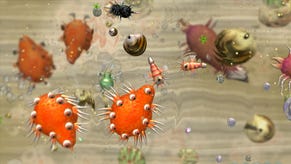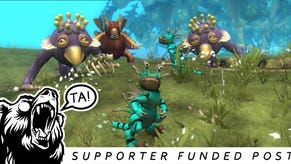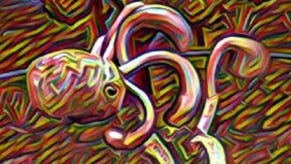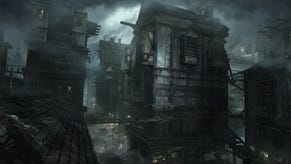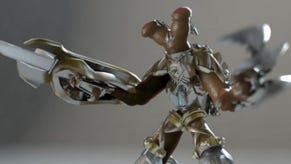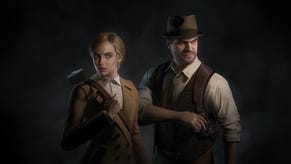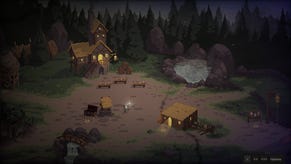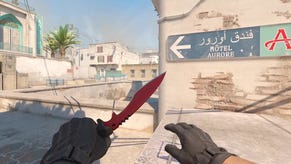Interview: Spore's Lead Designer On Spore's Design
Much like everyone else, we've been thinking far too much about Spore recently. Alex Hutchinson, the game's lead designer, has been thinking about it for years. With the game released, we grabbed the opportunity to talk candidly and extensively with him about its design choices. From high level decisions like the actual in-game effect of customisation to basic technical elements like the lack of autosave to the question of the sudden difficulty spike in Space (And the lack of difficulty elsewhere), he reveals Maxis' thinking. Whether you adore or abhor it, after reading this, you'll understand exactly why Spore is the game it is.

RPS: How did you decide upon the effect of customisation. As in, deciding that each part would have a specific effect rather based upon something in the design of the creature itself?
Alex Hutchinson: This was a really interesting, and ongoing debate on the team – early on there was one faction on the team that fervently believed creativity should have no impact on gameplay – that playing and creating were two totally separate activities, and that players should be able to create anything they wanted and then play any way they wanted. The second faction believed that creation and play were integral to each other, and that each editor should directly and powerfully impact each game.
There are many challenges with this – first, there’s just the basic argument that in a storytelling game like Spore (and our core aim was always to enable people to tell their own stories, not to ‘win’ per se) limiting people’s creativity is an essentially catastrophic decision and the more gameplay you bond to editors, the more you remove the player’s ability to tell their story of a mushroom headed toilet bowl who terrorized the earth, or the evil looking fang toothed monster who struggled to befriend the universe. If this was based purely on physical parts, both those stories are impossible, or at least terribly hard to communicate to players.
Also there’s a challenge with granularity - we originally had a formula for speed which was basically a curve that said that getting more legs made you faster until you had more than four legs, after which is it made you slower, but never made you as slow as someone with one leg, all of which was modified by the level and type of feet that you had and the mass of the entire creature. What we found however was that even people who thought they wanted that sort of calculation both didn't understand it and didn't like it when they were actually playing - the problem switched to 'my guy looks like he should run real fast but he doesn't, why?' and we'd say, well, you put five legs on him and that bulbous tail is actually really heavy, and people were both disappointed by the result and didn't understand it and they thought their creativity had been crushed.
Also, we originally had very fine grained stats for Creature Phase, down to a few decimal points, but we kept hitting issues where people would be .1% faster than their prey or .1% slower than their predators, so the interaction of chasing your lunch would eventually resolve but someone would be chasing the other creature across the planet for hours which obviously isn't very interesting or fun. It all comes down to what intellectually sounds brilliant but is practically painful.
We also had stats that I really liked such as 'cuteness' which looked at size and type of eyes, overall size and proportion of hands and feet etc but to be honest when you're making a casual game, it gets complicated super fast and as much as I am a hardcore gamer and would love to have semi-inscrutable stats smothering the game it just doesn't appeal to that many people and I really like making games that actual human beings can play and enjoy.
In the end we decided to cross streams basically, and begin with games that had a direct relationship between the act of creation and the in-game results, but end with games that allowed people to make whatever the wanted and then play separately. This also matched the aim of making the games themselves more complex as we moved forward, so that people who were perhaps not as familiar with games could begin with simpler games that were easier to digest before progressing to more complicated games that were more difficult to play on a conceptual level if you weren’t familiar with RTS conventions for example.
My personal position on this was that the editors are the heart of Spore, and that we should bond them as much as possible to gameplay, but the boon and the curse of games is that they’re giant collaborations. In the end I think it’s an interesting spin on creator based content – other developers who are interested in it as a theme can look at essentially four or five different implementations of the idea and hopefully move forward from that learning and make other great games.
RPS: Way back in the mists of time, there was a more free-moving water based stage rather than going straight onto line demoed. I presumed it was lost because the multi-axis movement is more complicated than the land-based two-axis movement, causing a break in the learning curve... is this right, or is there something else I'm missing?
Alex: That demo in ’05 was really a high concept pitch – the demo wasn’t an actual playable game yet, it was just a terrific visual presentation of what people hoped the game would eventually become. After that there was years of hard graft to get it back to that point and keep evolving it.
To be honest we never even really attempted to build that phase, as soon as production started we realized the mountain we had to climb with five different games – remember that means essentially five control schemes, five sets of user interface, five sets of everything... and all of it with a team that was only about 80 people which is well under the average team size these days for a big project.
The 3D movement would definitely have been a pain, and I think also it would have been hard to differentiate it from either the cell or creature phase – it feels like it would have been more filler than useful, although I’m sure there’s an interesting design in there somewhere.
RPS: Talking about that makes me wonder about the structure generally - since it amps up its complications slowly, was there ever a case in an earlier part of the game where you decided a mechanic, while interesting, was too complicated for that point in the curve? Or alternatively, give too much attention to that part of the game - as in, the sub games are meant to be progressive and if you get grabbed by an earlier stage and never want to move on, it's not going to work as a game about evolution?
Alex: I think the multiple game phases was the biggest nightmare for design – if you think about creature phase, for example, it has to get its content from cell phase, and then deliver it to tribal phase and beyond, which means a bunch of things: the world for creature phase, which is an avatar based pseudo-adventure game has remain playable for tribal phase and civilization phase, both of which are basic strategy games. An adventure game wants complex geometry, cool spaces to explore, perhaps physical challenges, while a real time strategy game wants lots of flat, empty spaces to move units through.
And that problem expands endlessly into all other facets of the game, from the challenges the tech team had to handle level of detail from essentially ground level all the way to looking at a planet from space, and on and on.
Essentially it meant that letting phases run in directions they wanted to go was more difficult than any other project I’ve ever worked on – we continually hit issues where a feature that might be fun for creature phase would essentially break tribal phase, or a feature that would be fun in creature phase was ‘too intelligent’ for a creature and had to be reserved for tribal phase.
Also, I fervently believed that for our game to give you a sense of progression – that your creations actually moved from small organisms to big creatures and then tribal creatures and then a civilization – and for you to actually see all the content that other people had made, and not just play once and then stop, the first four phases need to be playable on a Sunday afternoon.
Why did we build an infinite content machine if you’re only going to play once? Why did we make flexible editors for character and unit creation if you’re only going to make one set? Why make a story that’s about scale changes if the scale changes so gradually you can’t see it?
Spore is designed to let you tell your story, then wake up tomorrow and tell another story. It’s an unusual game. We also saw that people often enjoyed their second and later playthroughs more than their first, which I think is fascinating: I think this is partly because the game is so unusual, and it takes a loop to get your head around it so you can start pushing its boundaries, and I also think it’s about resetting expectations. The hype machine was so out of control, and the game wasn’t clearly an established genre of game, we always knew there would be people who would be disappointed because it wasn’t what they expected, but I just hope people will assess it based on what it tries to do and whether it succeeds, not on whether or not it’s the game they expected.
Those reviews which try to bash into established categories or break each level down individually to save themselves the difficulties of actually thinking about the game as a whole are pretty shallow in my opinion.
RPS: The game tends to take a gentle approach throughout majority of the game - so it's somewhat a surprise, upon reaching the Space stage where it's possible to fall into a seemingly unrecoverable hole relatively easily. What was the thinking behind the sudden leap, if you will? For me, it seems an odd conflict - in that the game manages to be casual and not casual at the same time.
Alex: I mentioned it earlier, but the idea was always to ramp up challenge and complexity as you played, but yeah that’s basically a tuning issue we’ll address soon. The desire was to have space feel like it ‘opened up’ the game and now you had the wonder of an entire universe in front of you, with limitless access to other people’s content, and also a game that you could play for several hours.
Space is designed to be a big phase you can sit in for as long as you want, and it needed to be more complex than earlier phases, but it was an interesting challenge. I quite liked the idea that casual players will enjoy the first phases more, then become less interested and perhaps just start again or play in the editors, and hardcore players will become more interested as the game progresses. We’ve seen that in reviews and in player feedback too, which I think is a good thing not a bad thing – it’s a giant game and there’s plenty to do for both players, but yeah I think it makes it challenging to boil down into a single idea.
The idea that a game might change its tone over time I think is interesting – most games are monotone (not monotonous, mind you) and by that I mean it starts as a shooter and ends as a shooter, so if you like the first five minutes you’ll like the last five – it’s an interesting idea to me to make a game where you might intrinsically love one half more than the other, so long as each half is robust enough to give people value for their time and money.
RPS: People have commented on various diversions the game took from evolution, one of the interesting ones I thought was characterising herbivores as communicative and building social networks - not that it's totally necessary, but watching people play seems that carnivores wipe the map at the creature stage while herbivores flirt up the map. I kind of presumed this was because while the carnivores interaction with other animals (i.e. Eating them) leads to a game with direction, herbivores... well, mostly don't interact with other species in such ways, so you have to abstract a little to make a game. Is that completely off base?
Alex: The interesting thing about herbivores, is that you sit down to assess their basic functionality and how you might put it in a game you realize that herbivores are basically lunch on legs. They actually don’t do anything that interesting (this is a generalization, obviously, to all you zoologists out there) but carnivores are generally smarter, more active, and have more interesting behaviors.
It’s no surprise that most games out there are about conflict and aggression – I don’t think that has anything to do with any ridiculous claims that games instill violence in people, I think it comes down to the fact that conflict is an easier mechanic to model and has strong in-built risk / reward structures that make it inherently fun.
But to hit the storytelling aims I’ve mentioned a few times already, people obviously needed to be able to make creatures that were non-violent. It’s core to the Maxis philosophy and core to Spore as a game and its hopes for mass appeal, that there should be ways to resolve the levels without killing everything.
In the Sims this was an easier problem because the Sims doesn’t have a win state, but once we realized you needed to finish each level to get to the next in Spore, we needed to model win states, which meant even social behavior needed a win state.
So when you imagine building a game based on non-violent behavior, it not only becomes a little more abstract – we chose music as a general theme – but it also becomes harder to explain in general, as it’s not as tightly mapped to ‘real world’ behaviors as we’d have liked.
Further down the chain, we were also trying to tie behaviors to parts in the editor, and to make that purchase decision interesting when making creatures, we needed a reason to map certain behaviors and functionality to groups and the mouth type divide seemed the most logical – it was also something we could use in cell to force the player to make a consequential decision. In other words, by choosing a certain mouth in cell you were already on a path in the creature phase so you should at least give it passing thought.

RPS: Okay - a break from the really fancy ones. Care to explain why Autosave was so hard to implement?
Alex: Haha I should get an engineer to pitch in here, but the logic was since we don’t support multiple saves, we didn’t want the player to do something save and then have no way to back out. The challenge with allowing more than one save is that the universe is persistent – so your save in this game is physically in the same universe as your other save, so if you save this game several times, which universe are you in when you load up another saved game on another planet and progress to space?
That said, it’s clearly not ideal and we’re taking another look at it. Now that the horror of finishing the game and putting it in a box is passed, issues like these will be re-examined and we’ll continue to support and grow the game you can be sure.
RPS: What do you think the biggest misunderstandings are about Spore?
Alex: Oh this is going to be a long one. Actually, I’ll just use one example so it hopefully carries more weight.
We designed spore to be three equal thirds: creating things in the creators, sharing things through the Sporepedia and invisibly in general play just by creating and playing, and then playing the games themselves.
That breaks down to lovely marketing simplification: create, share, play which was also very successful in the Sims.
The interesting thing about Spore, I that these thirds are intended to be equal. So it astounds me when I read commentary on the game that focuses only on the games, or dismisses the sharing aspects of the game.
It belies the fact that many people are only looking at the ‘game’ third, which means they’re ignoring or dismissing two thirds of the experience – I can understand why people might prefer one third, or even ignore another third, but to assume we didn’t deliberately put the weight of effort equally across the game is odd. We deliberately did things to the ‘game’ part of Spore to enable the editors to be more powerful – it’s no surprise that you can do virtually anything in the editors, as every time we had a potential design decision that would limit that, we chose to put the burden into the gameplay third, which was truly difficult, but it was the core assumption of the game. We were trying to do something different.
So I think the biggest misunderstanding is just that these thirds were not designed to be equal, or that there’s inherently more value in the game part than the creation or sharing part – I think that’s an assumption that will hold our industry back if we don’t break it, and I hope that Spore is successful enough to prove that.
RPS: Thanks for your time, Alex.
Alex: Thanks so much for the questions – feels good to chat about it all.







